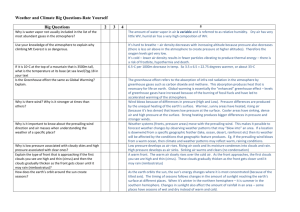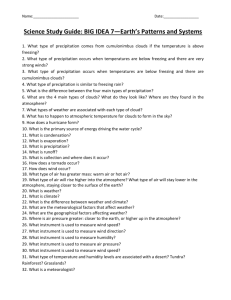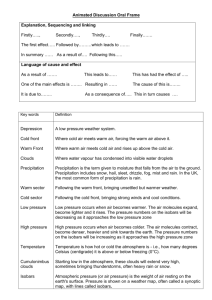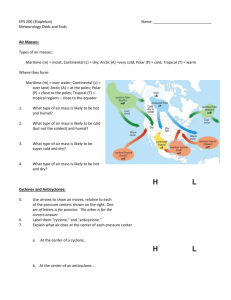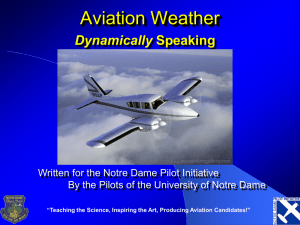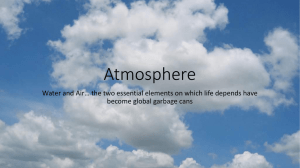Murphy_files/Study Guide for Meteorology Test 2
advertisement
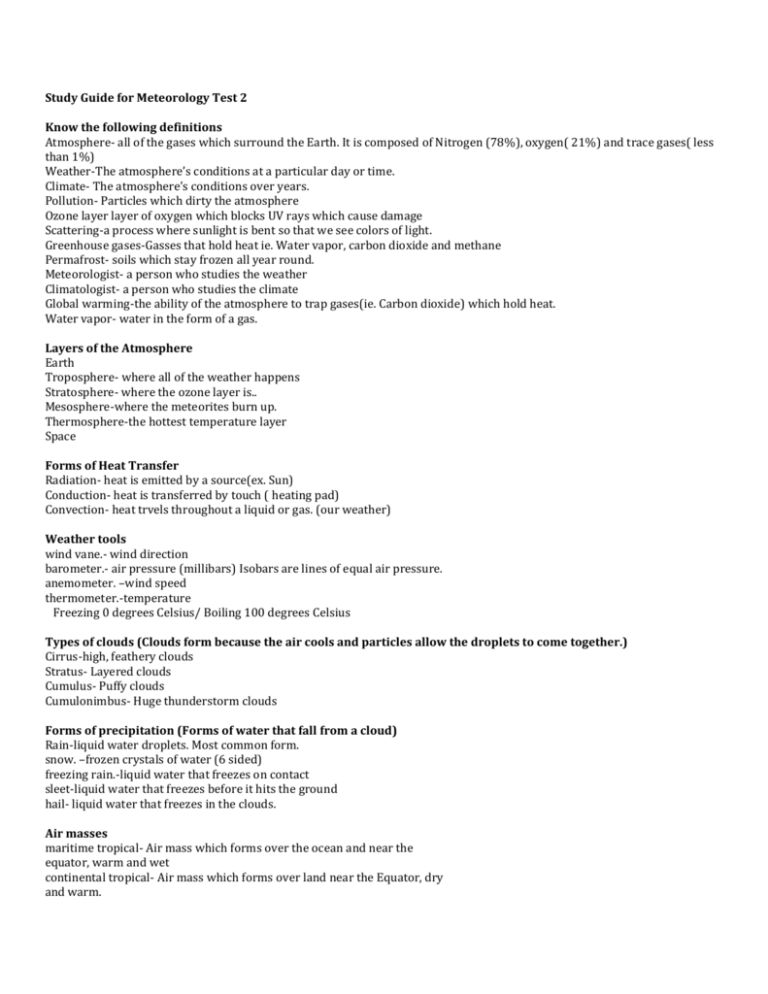
Study Guide for Meteorology Test 2 Know the following definitions Atmosphere- all of the gases which surround the Earth. It is composed of Nitrogen (78%), oxygen( 21%) and trace gases( less than 1%) Weather-The atmosphere’s conditions at a particular day or time. Climate- The atmosphere’s conditions over years. Pollution- Particles which dirty the atmosphere Ozone layer layer of oxygen which blocks UV rays which cause damage Scattering-a process where sunlight is bent so that we see colors of light. Greenhouse gases-Gasses that hold heat ie. Water vapor, carbon dioxide and methane Permafrost- soils which stay frozen all year round. Meteorologist- a person who studies the weather Climatologist- a person who studies the climate Global warming-the ability of the atmosphere to trap gases(ie. Carbon dioxide) which hold heat. Water vapor- water in the form of a gas. Layers of the Atmosphere Earth Troposphere- where all of the weather happens Stratosphere- where the ozone layer is.. Mesosphere-where the meteorites burn up. Thermosphere-the hottest temperature layer Space Forms of Heat Transfer Radiation- heat is emitted by a source(ex. Sun) Conduction- heat is transferred by touch ( heating pad) Convection- heat trvels throughout a liquid or gas. (our weather) Weather tools wind vane.- wind direction barometer.- air pressure (millibars) Isobars are lines of equal air pressure. anemometer. –wind speed thermometer.-temperature Freezing 0 degrees Celsius/ Boiling 100 degrees Celsius Types of clouds (Clouds form because the air cools and particles allow the droplets to come together.) Cirrus-high, feathery clouds Stratus- Layered clouds Cumulus- Puffy clouds Cumulonimbus- Huge thunderstorm clouds Forms of precipitation (Forms of water that fall from a cloud) Rain-liquid water droplets. Most common form. snow. –frozen crystals of water (6 sided) freezing rain.-liquid water that freezes on contact sleet-liquid water that freezes before it hits the ground hail- liquid water that freezes in the clouds. Air masses maritime tropical- Air mass which forms over the ocean and near the equator, warm and wet continental tropical- Air mass which forms over land near the Equator, dry and warm. maritime polar-Air mass which forms over the ocean near the poles, wet & cold continental polar- Air mass which forms over land near the poles. dry & cold Climate zones (based on temperature and precipitation) Polar- cold all year long, little precipitation (66.5- 90 North & South) Tropical- warm all year long, lots of precipitation (23.5 North to 23.5 South) Temperate- 4 seasons, temperature and precipitation varies with season (23.5 to 66.5 North and South) Pressure systems (Air has pressure because air has mass.) High-(anticyclone) clockwise winds, pushing out and downward. Low- (cyclone) counterclockwise winds, flowing inward and upward As air moves upward, its air pressure becomes less. Fronts (leading edge of air masses) Cold (a blue line with spikes or icicles) Warm (a red line with half-suns) Stationary- not moving ( red suns and blue spikes on opposite sides of a line) Occluded- a warm air mass being squeezed by 2 cold air masses. (purple spikes and suns on the same side of a line) Warnings/ Watches Watch- means conditions are favorable. Watch the skies to see if anything develops. Warning- means that the hazard has been sighted, take cover immediately. When you need to know what is happening with the radio, your best source of information is the NOAA weather radio. Be prepared with a safety kit. It should contain canned food, water, a first aid kit, flashlights, blankets, and other important items. Storms hurricanes.- huge, low pressure system with a calm eye, forms over warm water (biggest storm) Parts of a hurricane are inflow, outflow, eyewall/eye and rain bands. Hurricanes create the largest waves called storm surge. Lightning- a sudden discharge of electricity from a cloud. tornadoes.- small rotating funnel with the highest wind speeds, can happen all year round. thunderstorms.- Large storms with lightning, hail or large amounts of rain. snowstorms.- Storm with low temperatures, snow and ice. Wind can make you much colder than the the air temperature. This is called wind chill. Stay indoors. flooding- large amounts of precipitation causing rivers and creeks to overflow. (# 1 killer of people) Seasons Seasons are a result of the tilt of the Earth’s axis. When the axis is tilted towards the Sun we experience Summer. When it is away from the Sun, it is Winter; Spring and Fall are in between. EssaysKnow the difference between weather and climate. Know the safety rules for at least one form of hazardous weather. Why is the Earth’s atmosphere important to living things?



